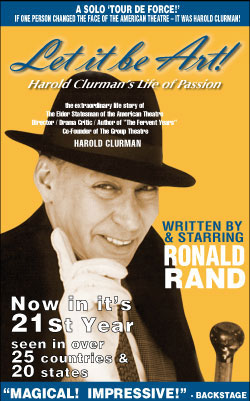Anna Halprin
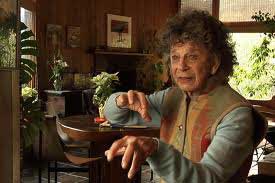 At 91 years of age, Ms. Halprin is “one of the most important theatre artists of the 20th century.” Her diverse career has spanned the field of dance since the late 1930’s, creating revolutionary directions for the art form and inspiring fellow choreographers to take modern dance to new dimensions. In 1955 she founded the groundbreaking San Francisco Dancer’s Workshop, and the Tamalpa Institute in 1978 with her daughter, Daria Halprin. Her students include Meredith Monk, Trisha Brown, Yvonne Rainer, Simone Forti, Dohee Lee, Dana Lova-Koga, Shinichi Momo Lova-Koga, Isak Immanuel, G. Hoffman Soto, some of who become involved in the progressive and experimental Judson Church Group. Over the years, her famous outdoor deck has been an explorative haven for numerous dancers and choreographers, including Merce Cunningham, Eiko and Koma, and Min Tanaka and Anne Collod who reconstructed “Parades and Change,” composers including John Cage, Luciano Berio, Terry Riley, LeMonte Young, and Morton Subotnick; visual artists including Robert Morris and Robert Whiteman; poets including Richard Brautigan, James Broughton, and Michael McClure. Ms. Halprin is an early pioneer in the expressive arts healing movement, leading numerous collaborative dance programs with terminally ill patients. She is long committed to a belief in the connection between movement and the healing power of dance. She has also investigated numerous social issues through dance and through theatrical innovations. For the past decade, she has led “Circle the Earth,” a contemporary community dance ritual to confront real-life issues facing participant communities around the world. Her “Planetary Dance: A Call for Peace” between peoples and the earth was staged in Berlin at an event commemorating the 50th anniversary of the signing of the Potsdam Treaty to end World War II, and involved over 400 participants. In 1995, she was invited by Mikhail Gorbachev to present an invocation at the State of the World Forum in California. Author of three books, she has released numerous videotapes about her work. She has created a hundred-fifty full-length dance theater works, which are extensively documented in photographs, books and on film. Ms. Halprin continues to make revolutionary work exploring the beauty of the aging body and its relationship to nature. Her recent works include the award -winning video “Returning Home.” In September 2004, she performed the confronting “Intensive Care: Reflections on Death and Dying” at the Festival D’Automne in Paris. In 2005, Ms. Halprin developed a filmed performance called “Seniors Rocking.” In 2006, The Museum of Contemporary Art presented a major one-woman exhibition of her life’s achievements. In 2009, the film “Breath Made Visible,” a documentary of her life and work premiered and has since been seen in cities around the world. In 2009, she presented "Spirit of Place" a tribute to Lawrence Halprin for his gift to the city at Stern Grove in San Francisco, and in 2011 she presented "Song of Songs" the first in a trilogy called "Remembering Lawrence,” her husband and long-time collaborator, at her Mountain Home Studio in Kentfield, California. She is the recipient of numerous honors and awards, including American Dance Festival’s Lifetime Achievement in Choreography Award, from the National Endowment for the Arts, Guggenheim Foundation, American Dance Guild, Samuel H. Scripps Award for Lifetime Achievement in Modern Dance, and many others. Author of three books, Moving Toward Life: Five Decades of Transformational Dance with Rachel Kaplan, Dance as A Healing Art, and Returning to Health: With Dance, Movement & Imagery, she has released numerous videotapes about her work. In 1997, Ms. Halprin received the Samuel H. Scripps Award for Lifetime Achievement in Modern Dance from the American Dance Festival. The Dance Heritage Coalition has named Anna Halprin one of “America’s Irreplaceable Dance Treasures.” She continues to perform, travel and teach with fervor.
At 91 years of age, Ms. Halprin is “one of the most important theatre artists of the 20th century.” Her diverse career has spanned the field of dance since the late 1930’s, creating revolutionary directions for the art form and inspiring fellow choreographers to take modern dance to new dimensions. In 1955 she founded the groundbreaking San Francisco Dancer’s Workshop, and the Tamalpa Institute in 1978 with her daughter, Daria Halprin. Her students include Meredith Monk, Trisha Brown, Yvonne Rainer, Simone Forti, Dohee Lee, Dana Lova-Koga, Shinichi Momo Lova-Koga, Isak Immanuel, G. Hoffman Soto, some of who become involved in the progressive and experimental Judson Church Group. Over the years, her famous outdoor deck has been an explorative haven for numerous dancers and choreographers, including Merce Cunningham, Eiko and Koma, and Min Tanaka and Anne Collod who reconstructed “Parades and Change,” composers including John Cage, Luciano Berio, Terry Riley, LeMonte Young, and Morton Subotnick; visual artists including Robert Morris and Robert Whiteman; poets including Richard Brautigan, James Broughton, and Michael McClure. Ms. Halprin is an early pioneer in the expressive arts healing movement, leading numerous collaborative dance programs with terminally ill patients. She is long committed to a belief in the connection between movement and the healing power of dance. She has also investigated numerous social issues through dance and through theatrical innovations. For the past decade, she has led “Circle the Earth,” a contemporary community dance ritual to confront real-life issues facing participant communities around the world. Her “Planetary Dance: A Call for Peace” between peoples and the earth was staged in Berlin at an event commemorating the 50th anniversary of the signing of the Potsdam Treaty to end World War II, and involved over 400 participants. In 1995, she was invited by Mikhail Gorbachev to present an invocation at the State of the World Forum in California. Author of three books, she has released numerous videotapes about her work. She has created a hundred-fifty full-length dance theater works, which are extensively documented in photographs, books and on film. Ms. Halprin continues to make revolutionary work exploring the beauty of the aging body and its relationship to nature. Her recent works include the award -winning video “Returning Home.” In September 2004, she performed the confronting “Intensive Care: Reflections on Death and Dying” at the Festival D’Automne in Paris. In 2005, Ms. Halprin developed a filmed performance called “Seniors Rocking.” In 2006, The Museum of Contemporary Art presented a major one-woman exhibition of her life’s achievements. In 2009, the film “Breath Made Visible,” a documentary of her life and work premiered and has since been seen in cities around the world. In 2009, she presented "Spirit of Place" a tribute to Lawrence Halprin for his gift to the city at Stern Grove in San Francisco, and in 2011 she presented "Song of Songs" the first in a trilogy called "Remembering Lawrence,” her husband and long-time collaborator, at her Mountain Home Studio in Kentfield, California. She is the recipient of numerous honors and awards, including American Dance Festival’s Lifetime Achievement in Choreography Award, from the National Endowment for the Arts, Guggenheim Foundation, American Dance Guild, Samuel H. Scripps Award for Lifetime Achievement in Modern Dance, and many others. Author of three books, Moving Toward Life: Five Decades of Transformational Dance with Rachel Kaplan, Dance as A Healing Art, and Returning to Health: With Dance, Movement & Imagery, she has released numerous videotapes about her work. In 1997, Ms. Halprin received the Samuel H. Scripps Award for Lifetime Achievement in Modern Dance from the American Dance Festival. The Dance Heritage Coalition has named Anna Halprin one of “America’s Irreplaceable Dance Treasures.” She continues to perform, travel and teach with fervor.
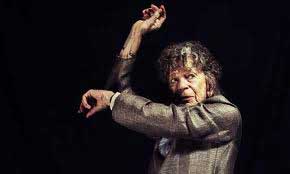
What are you currently at work on?
I just recently completed a huge project presented at the Berkeley Art Museum. It was a new version of parades and changes, which was first performed in this country in New York City at Hunter College. It has been referred to as “a performance that changed the definition of dance.” I was also arrested at that performance for indecent exposure.
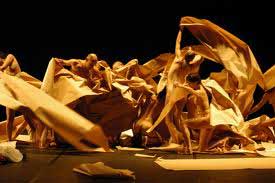
Another performance of parades and changes was presented at the Berkeley Art Museum when it opened thirty years ago and is now closing.
Currently I am in post-production working on editing a video of it. Soon I will be focusing on a new piece that is part of a trilogy called remembering Lawrence (Ms. Halprin’s husband). The first part of the trilogy was called “Spirit of Place,” and was performed at a site that Lawrence designed a park which was an amphitheater in San Francisco called Stern Grove.
The second piece was a series of events at Larry’s sites that he designed at the campus of the Berkeley University or more exact, the University of California in Berkeley I am currently preparing to start a new work is the third part of the trilogy called “Beyond Death.”
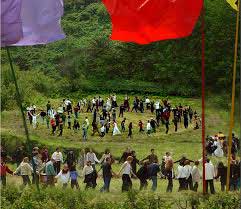
What have been some your strongest discoveries in creating dances in dealing with those who face life-threatening illnesses in their life?
What I discovered is that there is a difference between curing and healing. I feel that dance because our bodies are our instruments have the opportunity to heal but not necessarily cure but not any kind of dance has this possibility.
In the twenty-five years that I worked specifically with people with life-threatening illness, I realized the need not only to keep people physically fit but to help them learn how to develop an internal awareness of their physical bodies, and be able to express themselves through their bodies. Whether the expression is one of fear, hope, loss, enlightenment, regrets…whatever they are feeling with no withholdings. When the feedback process between movement and feelings are expressed freely there is a deep sense of satisfaction, release and change and fulfillment. Another healing is the opportunity to be with like-minded friends who are able to appreciate, share their deepest feelings, and work together for each other’s healing. I have two videotapes that I recommend that everyone view and you can see for yourself the healing effects of dance. One is called “Positive Motion,” and the other is called “Dance for Life.” They will perhaps give you a better idea of what I'm trying to say. Another video is “Breath Made Visible,” too. When you look at these videos I believe you’ll see what I mean, as well if not better than I can, as I am too close to the situation.
What are some of the most valuable things you learn from your students?
The most valuable things I learned is how normal, easy, important it is to be able to generate their own creativity. I like to leave a class saying to myself, “Wow! How inspirational these students are!” rather than “What a good class I taught.”
Creativity for me is the key word and is exciting because what they do is original and uniquely their own. I am always amazed by the diverse city and uniqueness of each students’ creative expression. This is the most valuable thing I learned from my students – the life affirmation of each individuals’ stunning creativity.
On a more self-serving level they respond to my scores in a way that provides me with new and fresh resources and ideas that I would never have imagined so that I can get from class as much as I give to a class.
How did you come to the realization and desire to adapt your work to the present moment?
It’s hard for me to answer that question because I don't know any other way to present work
How have you learned to quiet your mind to allow true expression to occur?
I have developed a series of processes that guide my students into internalizing this involves a series of exercises. Awareness exercises that focus on breathing and other sensorial internalized body like hearing, relaxing, eyes, jaws, facial expressions, the sensation of and sound of birds, smell and so forth . This can take anywhere from ten to thirty minutes before the student is ready to dance.
Another good way to internalize is shaking movements. Shaking movements will give you time to be out of your head. You instantly start feeling your body.
To answer a question like this however really depends on each situation. There never is just one way to do something, to achieve a particular result.•























